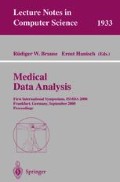Abstract
Genetic Programming is used to generate pulse sequence elements for a Nuclear Magnetic Resonance system and evaluate them directly on that system without human intervention. The method is used to optimise pulse shapes for a series of solvent suppression problems. The method proves to be successful, with results showing an improvement in fitness of up to two orders of magnitude. The method is capable of producing both simple and novel solutions.
Access this chapter
Tax calculation will be finalised at checkout
Purchases are for personal use only
Preview
Unable to display preview. Download preview PDF.
References
Koza,.J.: Genetic Programming: On the Programming of Computers by Means of Natural Selection. MIT Press, Cambridge, Massachusetts (1992)
Gray, H., Maxwell, R., Martinez-Perez, I., Arus, C., Cerdan, S.: Genetic Programming for Classification and Feature Selection: Analysis of 1H Nuclear Magnetic Resonance Spectra from Human Brain Tumour Biopsies. NMR in Biomedicine 11 (1998) 217–224
Poli, R., Cagnoni, S.: Genetic Programming with User-Driven Selection: Experiments on the Evolution of Algorithms for Image Enhancement. In Koza et al (ed.), Genetic Programming 1997: Proceedings of the Second Annual Conference (1997) 269–277, Morgan Kaufmann
van den Broek, W., Wienke, D., Melssen, W., Buydens, L.: Optimal Wavelength Range selection by a Genetic Algorithm for Discrimination Purposes in Spectroscopic Infrared Imaging. Applied Spectroscopy 51:8 (1997) 1210–1217
Assion, A., Baumert, T., Bergt, M., Brixner, T., Kiefer, B., Seyfried, V., Strehle, M., Gerber, G.: Control of Chemical Reactions by Feedback-Optimized PhaseShaped Femtosecond Laser Pulses. Science 282 (1998) 919–922
Freeman, R., Wu, X.: Design of Magnetic Resonance Experiments by Genetic Evolution. Journal of Magnetic Resonance 75 (1987) 184–189
Geen, H., Freeman, R.: Band-Selective Radiofrequency Pulses. Journal of Magnetic Resonance 93 (1991) 93–141
Zongker, D., Punch, B.: Lil-gp User’s Manual. Michigan State University (1996)
Author information
Authors and Affiliations
Editor information
Editors and Affiliations
Rights and permissions
Copyright information
© 2000 Springer-Verlag Berlin Heidelberg
About this paper
Cite this paper
Frances Gray, H., James Maxwell, R. (2000). Genetic Programming Optimisation of Nuclear Magnetic Resonance Pulse Shapes. In: Brause, R.W., Hanisch, E. (eds) Medical Data Analysis. ISMDA 2000. Lecture Notes in Computer Science, vol 1933. Springer, Berlin, Heidelberg. https://doi.org/10.1007/3-540-39949-6_30
Download citation
DOI: https://doi.org/10.1007/3-540-39949-6_30
Published:
Publisher Name: Springer, Berlin, Heidelberg
Print ISBN: 978-3-540-41089-8
Online ISBN: 978-3-540-39949-0
eBook Packages: Springer Book Archive

